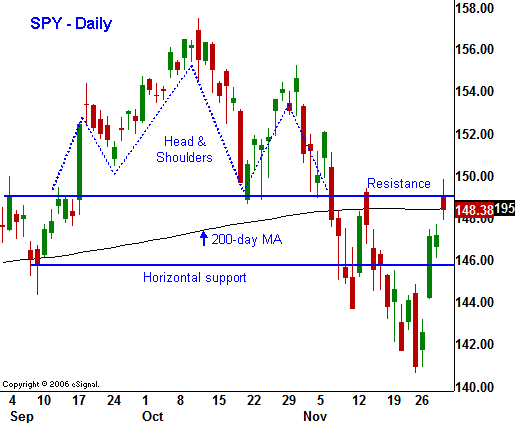When It Runs Out Of Steam, Sell This Rally!
This week the market staged a huge rally and we witnessed the largest two-day gain in the last five years. The Fed hinted that it might ease in December and the market shot higher. A number of influences exacerbated the move. The market had corrected 10% from its October high, end-of-month fund buying supported prices and oversold condition fueled a short covering rally.
Throughout the week, the economic news was very weak. The durable goods number would have declined by .9% if not for a 16% rise in defense spending. Housing sales were up 1.7% last month but that number does not include cancellations and some national builders have reported cancellation rates around 50%. Home sales are down 23.5% in the past year and the September to October median sales price fell 8.6%, the biggest monthly price drop in 26 years. The Beige Book confirmed an economic slowdown and most of the GDP gains were attributed to a buildup in inventories.
Tuesday the Fed officials cut their growth forecast in 2008 to range of 1.8% to 2.5%, down from the previous forecast of 2.5% to 2.75%. They are expecting an uptick in unemployment to 4.9% by the end of next year. That forecast was consistent with the higher than expected jobless claims number which rose to a two-year high.
Most people don't realize that 50% of the job growth from the year 2001 to 2005 was related to the housing boom. Layoffs in that industry typically materialize 6-12 months after the peak. The typical housing cycle lasts 18-54 months and given that this boom was the biggest ever, we should expect the decline to last longer.
Last month's unemployment number showed an employment increase in the financial sector. Given all of the announced layoffs and cutbacks, we know that will change dramatically this month. Seasonally, retailers add employees at this time, but slow sales will translate into less hiring.
If the unemployment rate starts to rise, the credit problems will accelerate quickly. Consumer debt levels are high and we recently concluded a 24-month stretch where the personal savings rate was negative (people spent more than they made).
The Fed will lower interest rates and they are worried about the economy. They are painting themselves into a corner and it is just a matter of time until they run out of bullets. The dollar is in a long-term downtrend and it has reached a 30-year low against most major currencies. This is inflationary and lowering interest rates will only add to the problem.
Two months ago the market rallied on an aggressive move by the Fed and the economic numbers did not support their action. The economic numbers were still strong and it was hard to tell if the Fed was catering to the financial community or if the concerns were legitimate. I knew those numbers were backwards looking, but I had to go on the information I had. Consequently, I maintained my bullish bias until I had proof. I did not want to fade a 5-year bull market of a strong seasonal trend. Now that the weakness is starting to show itself, I am concerned that we are headed for trouble.
Lower interest rates won't fix what ails us this time around. After 9/11, lower interest rates gave homeowners the opportunity to refinance at lower rates. This was a windfall opportunity and people spent the extra money from this maneuver. Smart homeowners locked into low fixed rates that are way below the current rates and that means that marginally lower interest rates will not release the same amount of cash that we saw five years ago. New homeowners that opted for three and five year ARMS will be helped by lower interest rates, however their fixed-rate will still be much higher than their earlier rates and they will have to cut back their consumption to meet their higher mortgage payments (the one positive to a rate cut is that many homeowners might be able to avoid foreclosure). Today, Treasury Secretary Paulson announced that he is trying to put together a plan that will freeze adjustable-rate mortgages for the next year.
When mortgage companies construct these loans they hedge themselves based on the terms of the loan. If they agree to this freeze”, they are certain to lose money since their cost of capital has increased and their hedge has expired. The losses might be less than if they went through the process of foreclosure. From the perspective of the homeowner, the inevitable is being postponed. I don't believe that economic conditions are going to change much in the next year and in fact, the Fed is forecasting that they will deteriorate.
I have more information than I had a month ago and I do not like what I see. An interest rate cut is only a Band-Aid and bigger problems loom. The rate cut is priced in and once the reality sets in, I believe we will see another round of selling.
At very least, I believe this is a good opportunity to sell out of the money calls spreads on stocks that have been in a downtrend and have bounced this week. Wait for the momentum from that bounce to stall before taking a position. Aggressive accounts can start buying puts if the SPY closes below 148 today and they can add if the SPY closes below 146 next week.
Keep in mind that this market has been very volatile and trade smaller size.


Daily Bulletin Continues...

